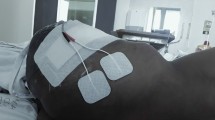Abstract
Objective
Phantom limb pain is characterized by painful sensations that emanate from portions of an amputated limb and has a prevalence estimated as high as 75–80%. Radiofrequency, which is used interventionally as either pain-ablation or neuromodulation for axial pain, has also been increasingly used for non-axial pain. To conduct a systematic review to determine the therapeutic response of radiofrequency techniques for post-amputation phantom limb pain.
Design/Methods
A comprehensive search of several databases from January 1, 2000, to November 23, 2020, was conducted. Eligible study designs included randomized controlled trials, prospective and retrospective studies, cross-sectional studies, case series, and case reports. The risk of bias was assessed using a tool specifically for assessing case series and case reports. We assessed the level of evidence using the Oxford tool and the quality of evidence with GRADE. A total of 98 articles were screened, with nine studies meeting inclusion criteria.
Results
Five studies had a moderate risk of bias, and four had a high risk of bias. All nine studies, including three case series and six case reports, discussed phantom limb pain treatment for fourteen patients by various radiofrequency techniques, including radiofrequency ablation, cooled radiofrequency ablation, pulsed radiofrequency, and low-temperature plasma radiofrequency ablation. Of the fourteen patients receiving one of the radiofrequency techniques, eleven (78.6%) received ≥ 50% pain relief post-intervention. No adverse effects were seen in any of the included studies.
Conclusions
Despite the limited quantity and quality of evidence, radiofrequency techniques show potential therapeutic benefits for phantom limb pain.


Similar content being viewed by others
Data Availability
All data are included in the manuscript.
Code Availability
Not applicable.
References
Papers of particular interest, published recently, have been highlighted as: • Of importance
Kapural L, Mekhail N. Radiofrequency ablation for chronic pain control. Current Science Inc. 2001;5(6):517–25. https://doi.org/10.1007/s11916-001-0069-z.
Kern U, Busch V, Müller R, et al. Phantom limb pain in daily practice – still a lot of work to do! Pain Med. 2012;13:1611–26. https://doi.org/10.1111/j.1526-4637.2012.01494.x.
Murad MH, Sultan S, Haffar S, et al. Methodological quality and synthesis of case series and case reports. BMJ Evid Based Med. 2018;23(2):60–3. https://doi.org/10.1136/bmjebm-2017-110853.
OCEBM Levels of Evidence Working Group. The Oxford 2011 Levels of Evidence. Oxford, UK: Oxford centre for evidence-based medicine. https://www.cebm.ox.ac.uk/resources/levels-of-evidence/oxford-centre-for-evidence-based-medicine-levels-of-evidence-march-2009. Accessed 15 Mar 2021.
Guyatt G, Oxman AD, Akl EA, et al. GRADE guidelines: 1 Introduction-GRADE evidence profiles and summary of findings tables. J Clin Epidemiol. 2011;64(4):383–94. https://doi.org/10.1016/j.jclinepi.2010.04.026.
Nia S, Greenwald A, Sifonios A, et al. Radiofrequency ablation of sciatic nerve neuroma for treatment of phantom limb pain: a case report. Reg Anesth Pain Med. 2015;40(5)
Zhang X, Xu Y, Zhou J, et al. Ultrasound-guided alcohol neurolysis and radiofrequency ablation of painful stump neuroma: effective treatments for post-amputation pain. J Pain Res. 2017;10:295–302. https://doi.org/10.2147/JPR.S127157.
Sperry BP, Cheney CW, Conger A, et al. Cooled radiofrequency ablation of a large sciatic neuroma at the infrapiriformis foramen for recalcitrant phantom limb pain in a below-knee amputee. Pain Med. 2020;0(0):1-4. https://doi.org/10.1093/pm/pnaa154
Brzeziński K, Rękas-Dudziak AR, Maruszewska A. Pulsed radiofrequency as alternative method for phantom pain treatment, case report. Clin Case Rep. 2020;8(10):2060–2. https://doi.org/10.1002/ccr3.3110.
Imani F, Gharaei H, Rezvani M. Pulsed radiofrequency of lumbar dorsal root ganglion for chronic postamputation phantom pain. Anesth Pain Med. 2012;1(3):194–7. https://doi.org/10.5812/kowsar.22287523.3768.
West M, Wu H. Pulsed radiofrequency ablation for residual and phantom limb pain: a case series. Pain Pract. 2010;10(5):485–91. https://doi.org/10.1111/j.1533-2500.2009.00353.x.
Wilkes D, Ganceres N, Solanki D, et al. Pulsed radiofrequency treatment of lower extremity phantom limb pain. Clin J Pain. 2008;24(8):736–9. https://doi.org/10.1097/AJP.0b013e318170d758.
Li H, Li Y, Guo Z, et al. Low-temperature plasma radiofrequency ablation in phantom limb pain: a case report. Brain Circ. 2018;4(2):62–4. https://doi.org/10.4103/bc.bc_7_17.
Zeng Y, Wang X, Guo Y, et al. Coblation of femoral and sciatic nerve for stump pain and phantom limb pain: a case report. Pain Pract. 2016;16(2):35–41. https://doi.org/10.1111/papr.12400.
Ojango C, Raguso M, Fiori R, et al. Pulse-dose radiofrequency treatment in pain management-initial experience. Skeletal Radiol. 2018;47(5):609–18. https://doi.org/10.1007/s00256-017-2854-8.
Vallejo R, Benyamin R, Tilley DM, et al. An ex vivo comparison of cooled-radiofrequency and bipolar-radiofrequency lesion size and the effect of injected fluids. Reg Anesth Pain Med. 2014;39(4):312–21. https://doi.org/10.1097/AAP.0000000000000090.
Zachariah C, Mayeux J, Alas G, et al. Physiological and functional responses of water-cooled versus traditional radiofrequency ablation of peripheral nerves in rats. Reg Anesth Pain Med. 2020;45(10):792–8. https://doi.org/10.1136/rapm-2020-101361.
McCormick Z, University of Utah. C-RFA of residual limb neuroma. 2019. https://clinicaltrials.gov/ct2/show/NCT04538417. Accessed 15 Mar 2021.
Author information
Authors and Affiliations
Corresponding author
Ethics declarations
Conflict of Interest
The authors declare no competing interests.
Additional information
Publisher's Note
Springer Nature remains neutral with regard to jurisdictional claims in published maps and institutional affiliations.
This article is part of the Topical Collection on Amputation Rehabilitation
Rights and permissions
About this article
Cite this article
Meiling, J.B., Raum, G.M., Barndt, B.S. et al. Radiofrequency Techniques for the Alleviation of Post-amputation Phantom Limb Pain: a Systematic Review. Curr Phys Med Rehabil Rep 9, 207–214 (2021). https://doi.org/10.1007/s40141-021-00328-1
Accepted:
Published:
Issue Date:
DOI: https://doi.org/10.1007/s40141-021-00328-1




